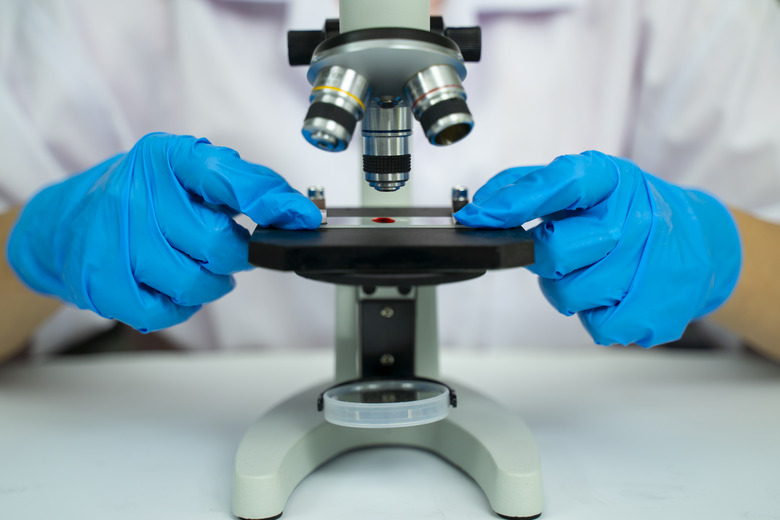Stucture Of A Cell Membrane
Only a very thin, flexible barrier separates the contents of a cell from its environment. The cell membrane function selectively allows the exchange and passage of certain molecules while keeping unwanted substances out. Parts of the cell membrane also allow the cell to communicate with other cells and the environment around it. Both plants and animals possess cell membranes, but their cell membrane structure and organization differs, as plants, yeast and bacteria have a rigid cell wall outside of the membrane for additional support and structure. The unique functions of the cell membrane dictate its structure and properties.
Phospholipid Component
Phospholipid Component
A two-layer structure of special lipid molecules, called phospholipids, constitutes the cell membrane. Each phospholipid has two fatty-acid chains attached to a phosphate-glycerol head. The fatty acids are hydrophobic (water-hating) where as the phosphate head is hydrophilic (water-loving). The two layers of phospholipids position themselves such that the fatty acids are inside the layers or leaflets. According to "Carnegie-Mellon: The Structure and Function of the Cell Membrane", when the bilayer membrane comes in contact with water, the phospholipid molecules rearrange themselves to keep the fatty acid tails away from water.
Protein Component
Protein Component
Two kinds of proteins are scattered throughout the cell membrane: integral proteins and peripheral proteins. Integral proteins, made from long chains of amino acids, pass through the entire membrane. Some parts of the protein interact with the exterior environment and other parts interact with the cell interior. Hence, integral proteins are also termed transmembrane proteins. Integral proteins have two major functions. They act as pores that allow certain "ions or nutrients into the cell" and they "transmit signals into and out of the cell", according to James Burnette III in the Carnegie-Mellon article.
In contrast, peripheral proteins attach only to the membrane surface and serve as anchors for the cytoskeleton or extracellular fibers.
Carbohydrates and Cholesterols
Carbohydrates and Cholesterols
A carbohydrate coat known as glycocalyx covers the cell surface. The glycocalyx is made of short oligosaccharides attached to certain types of transmembrane proteins. According to "The Cell: Structure of the Plasma Membrane", the glycocalyx provides the identity of a cell. It basically provides a set of markers that can distinguish between identical cells and foreign or invading cells. The glycocalyx also serves to protect the cell surface.
Cholesterols are another type of lipids found on the cell membrane. Scattered throughout the fatty acid interior, cholesterols prevent the tails from packing too tightly and help keep the membrane fluid.
Mosaic Property
Mosaic Property
First proposed by Singer and Nicolson ("Science", February 18, 1972) as the Fluid Mosaic Model, the cell membrane has two essential features that allow it to perform its functions. First, the cell membrane is a mosaic structure of different molecules. Each type of cell in multicellular and unicellular organisms will have a unique collection and combination of proteins, carbohydrates and lipids. As an example, Burnette of Carnegie-Mellon mentions that the membrane of red blood cells has more than 50 kinds of proteins.
Fluid Property
Fluid Property
The second property of the cell membrane is its fluidity. The phospholipids move freely about and rearrange themselves within each layer of the membrane but they rarely cross the hydrophobic region and transfer to the opposite layer, according to Burnette. The hydrophilic heads are always on the outer periphery and the hydrophobic tails stay in the core of the bilayer.
The fluid property of the membrane results in asymmetrical bilayers. Burnette describes that, in response to changing environments or differing temperatures inside and outside the cell, there may be more proteins or carbohydrate molecules on each layer at any one time, allowing for the selective passage of molecules and ions across the membrane.
An illustration of the fluid mosaic properties of the cell membrane is presented at "Carnegie-Mellon: The Structure and Function of the Cell Membrane".
Cite This Article
MLA
Ibay, Grace. "Stucture Of A Cell Membrane" sciencing.com, https://www.sciencing.com/stucture-cell-membrane-6382385/. 6 August 2018.
APA
Ibay, Grace. (2018, August 6). Stucture Of A Cell Membrane. sciencing.com. Retrieved from https://www.sciencing.com/stucture-cell-membrane-6382385/
Chicago
Ibay, Grace. Stucture Of A Cell Membrane last modified March 24, 2022. https://www.sciencing.com/stucture-cell-membrane-6382385/
